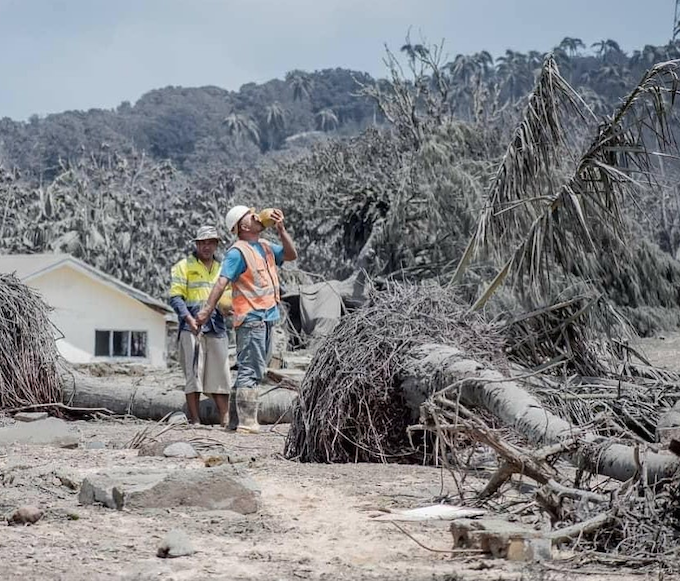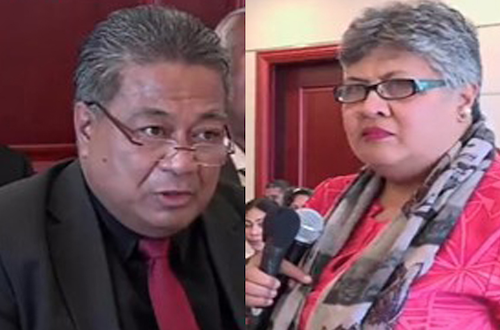
By Kalino Latu in Auckland
The managing director of Radio FM Broadcom, Katalina Tohi, asked Tonga’s disaster minister during last Sunday’s media conference to explain whether the kingdom’s warning sirens were damaged.
“I did not hear the sirens. Maybe Poasi [Tei] will explain what had happened,” Tohi said in Tongan discussing the devastation of the Hunga Tonga-Hunga Ha’apai undersea volcano eruption and tsumani on January 15.
She told the media conference it was important to be cautious about what they would do and what instruction they should give to people if a disaster like this happened again.
- READ MORE: Concern grows over psychological trauma amid Tonga’s recovery
- Australia and New Zealand compete with China for Tongan influence
- Global aid effort underway for Tonga’s recovery from the Hunga tsunami
- Other Tonga volcano eruption reports
Tohi also said the police had to order people who were at the Nuku’alofa waterfront watching the Hunga eruptions to leave and go to higher ground, meaning the people were unaware a tsunami was coming.
Disaster Minister and Deputy Prime Minister Poasi Tei did not answer the question directly, instead saying that when he was assured a tsunami was coming, he immediately called the director of the Met Service and told him to “sound the alarm for evacuation”.
He did not say what happened to the siren and whether the alarm he was referring to was meant for the sirens.
The minister said he was at his home on the day of the tsunami when he heard the explosion from the Hungas. He did not mention hearing any sirens.
The Kaniva News correspondent in Tongatapu said no sirens were heard, even when the waves started flooding Nuku’alofa in the afternoon. He said the sirens were allegedly damaged.
The correspondent said the government’s tsunami warnings were announced on radio.
Sirens could have forewarned residents
Critics believed a siren warning might have helped warn some residents in time to flee to higher ground.
An earlier warning might have given them time to take provisions with them. This would have been especially helpful on the islands of ‘Atatā and Mango.
Local reports said that about six hours elapsed before the tsunami hit Tongatapu. People lined up at the Nuku’alofa waterfront, which is 65km from the Hungas, to watch an unusual swirling of the water.
The same unusual activity was seen in the waters around Mango the same morning.
A report from Kanokupolu, which was the hardest-hit town in Tongatapu, said a tsunami hit the town before the deafening explosion was heard from the Hungas.
Many believed if the sirens had been working, they could have been sounded ahead of the shockwaves striking the islands.
Local media who interviewed the Mango evacuees after they arrived in Nuku’alofa revealed the survivors were uninformed and they did not mention hearing any sirens.
Many said the tsunami happened so quickly and suddenly — and that they were “absolutely unprepared”.

Children warn parents
Some parents said before the tsunami hit they were busy with their normal preparation of food and cooking for the following day, which was Sunday. They only became aware of the deadly waves coming after their children called at them to look at the sea.
Some said they were confused when they heard people yelling at them to run.
They said when the first explosion was heard the big waves had already crashed into the middle of the village, destroying houses and trees.
They found their first high ground to take refuge, but the waves were so big they had to keep running into the bush before they felt safe.
Fear of famine
There was a fear of a possible famine in Tonga after the tsunami caused significant damage and wiped out some towns and islands. It also blanketed the whole of Tongatapu with a thick layer of volcanic ash.
Most plantations are dying while families are struggling to clean up the dust brought inland by one of the world’s most powerful volcanic eruptions.
Dead animals
Meanwhile, the public is being warned to keep away from places which are littered with animal carcasses drowned in the tsunami.
Locals have been left retching over the putrid smell of rotting cows and pigs.
Work to remove the animal remains are in progress in Tongatapu, especially in the town of Kanokupolu.
Republished with permission. Asia Pacific Report collaborates with Kaniva Tonga News.











































It’s easy to be critical about the lack of sirens in a disaster situation like this. But these are small Pacific islands where infrastructure is minimal and warning systems often depend on an initial alert from the Pacific Tsunami Warning Center in Honolulu. Countries on the Pacific rim of fire like Tonga, Fiji, Vanuatu, PNG, Indonesia etc can be hit by a local earthquake or volcano which can generate a tsunami that will hit the local shoreline within 15 to 30 minutes. That requires local expertise and public education. I’m sure there’ll be studies on this disaster with recommendations to prepare these island nations for disasters like these (even if it might 1/100 years!)
Comments are closed.